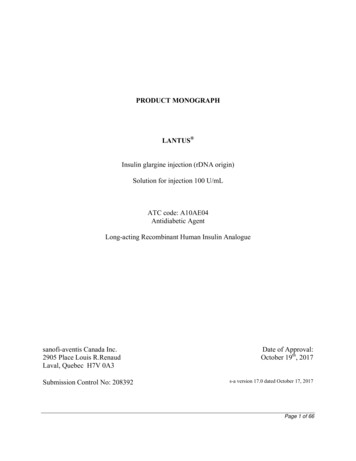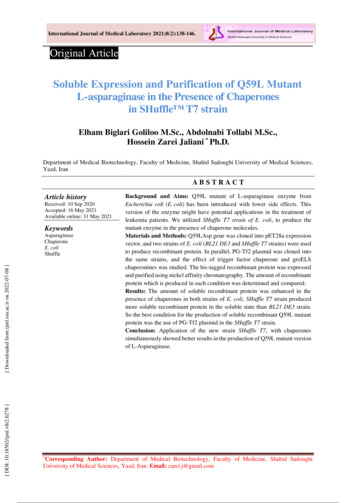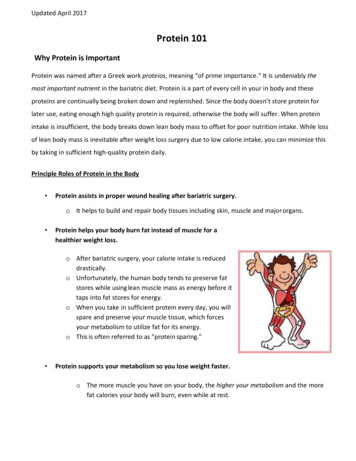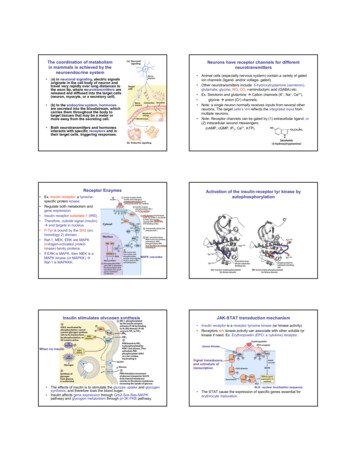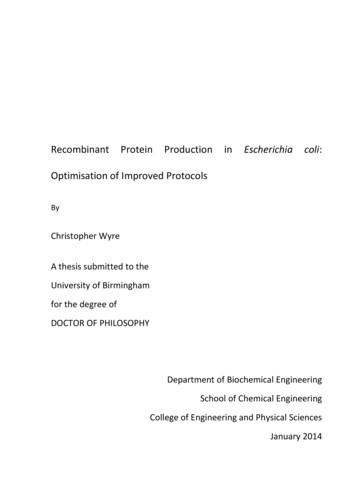
Transcription
misation of Improved ProtocolsByChristopher WyreA thesis submitted to theUniversity of Birminghamfor the degree ofDOCTOR OF PHILOSOPHYDepartment of Biochemical EngineeringSchool of Chemical EngineeringCollege of Engineering and Physical SciencesJanuary 2014
University of Birmingham Research Archivee-theses repositoryThis unpublished thesis/dissertation is copyright of the author and/or thirdparties. The intellectual property rights of the author or third parties in respectof this work are as defined by The Copyright Designs and Patents Act 1988 oras modified by any successor legislation.Any use made of information contained in this thesis/dissertation must be inaccordance with that legislation and must be properly acknowledged. Furtherdistribution or reproduction in any format is prohibited without the permissionof the copyright holder.
AbstractRecombinant protein production (RPP) in E. coli is a cornerstone of modernbioprocessing, especially for biopharmaceutical production. This study presents workaimed at developing analytical techniques and production protocols for RPP in E. coli,particularly with reference to industrial applications.Flow cytometry (FCM) was used routinely to monitor cell physiology and RPP itselfthrough the production of CheY::GFP a fluorescent model protein. Further applicationsof FCM for monitoring RPP processes were also developed. A protocol was developed toidentify CheY::GFP inclusion bodies produced under high-stress conditions using theamyloidophilic fluorescent dye Congo red. FCM analysis was also applied to RPP processstages that are currently little studied, agar plate and early-stage liquid cultures. FCMscreening of transformants expressing CheY::GFP on agar plates identified abnormal,likely mutated cells. Further analysis identified 3 populations of varying fluorescenceintensity and the progressive transfer of cells from the high fluorescence population toone of intermediate fluorescence along with a progressive loss of culturability. This wasshown to be the result of amyloid inclusion body formation by Congo red staining. FCManalysis of agar-plate and early-stage liquid culture is therefore proposed as a useful(and currently under–exploited) analytical step for RPP processes.RPP conditions that minimise physiological stress by reducing growth temperature andinducer concentration can increase product yields, solubility and biomass yields. In thisstudy stress-minimised production conditions were applied to industrially-derived RPPfermentation protocols. The original complex-medium based fermentation protocolused for stress-minimised RPP showed substantial limitations for industrial use.Application of stress-minimised conditions to a semi-defined medium-based protocolusing both early and late-phase induction and glucose or glycerol as carbon source wasshown to be successful with high yields of biomass, total CheY::GFP and solubleCheY::GFP (up to 77.5 g·L-1, 15.7 g·L-1 and 7.1 g·L-1, respectively). The protocolsdeveloped in this study improved biomass generation, product formation andreproducibility over both the original stress-minimised and unmodified industriallyderived protocols. It is therefore concluded that stress-minimisation is of potentialindustrial use.Adaptation of a defined growth medium fermentation for stress-minimisation showedlimited success due to nitrogen and phosphate limitation in the initial growth medium.Further analysis of nitrogen and phosphorus content showed that the complex mediumwas likely phosphate limited and that the semi-defined medium was likely nitrogenlimited. It was concluded that with further adaptation a stress-minimised definedmedium protocol will be possible.II
This work is dedicated to my grandparents.I still can’t believe you won’t see this
AcknowledgmentsFirst I would like to thank Dr Tim Overton for his excellent supervision, support andguidance throughout this project and for allowing me this opportunity for which Iam very grateful. Thanks also to Prof Colin Thomas for his valuable comments onthis thesis.For their help and support both in the lab and out my thanks go to Isaac VizcainoCaston, Amir Anvarian and Louise Hackett.Also I would like to thank all my colleagues from Biochemical Engineeringespecially, Reza Jalalirad, Evan Hsu, Neeraj Jumbu and Trong Duangkanok.For their excellent technical assistance I would like to thank Elaine Mitchell, DavidFrench, Ronnie Baglin, Christine Fletcher and the late Hazel Jennings.From the School of Biosciences I would like to thank Prof Jeff Cole for his insightsand assistance, and to members of his research group past and present for their helpand the provision of strains, plasmids etc., especially Yanina Sevastsyanovich, SaraAlfasi and Lenny Zaffaroni.Financially I would like to acknowledge the support of the BBSRC who funded thisproject and to the SGM for kindly providing me with a student travel grant.Finally, I must thank my family without whose constant support I could not havedone this.
Table of ContentsChapter 1: Introduction & Literature Review . 11.1. Uses & importance of RPP . 21.1.1. Pharmaceutical, biotechnological & research uses . 21.1.2. Systems, uses & limitations. . 31.1.2.1. Bacterial systems. 31.1.2.2. E. coli . 71.1.2.3. Other Bacteria. 81.1.2.4. Yeast . 81.1.2.5. Higher eukaryotic systems . 91.1.2.6. Cell-free systems . 91.2. RPP in E. coli.101.2.1. Methods of production .101.2.1.1. Subcellular localisation . 131.2.1.2. Conformational state . 161.2.2. Common RPP systems in E. coli.171.2.2.1. Induction. 171.2.2.2. lac promoter-based systems . 181.2.2.3. Other chemically-induced systems . 201.2.2.4. Bacteriophage λ-based systems . 211.2.2.5. Bacteriophage T7 RNA polymerase-based systems . 211.2.3. Strains .231.2.3.1. E. coli BL21 and derivatives . 231.2.3.2. Other (DE3) strains . 261.3. Physiological stress during RPP & the improved protocol .261.3.1. Mis-folded protein and the heat shock response .271.3.2. Nutrient depletion and the stringent response .291.3.3. RpoS and the general stress response .301.3.4. Effects of RPP-induced stress .311.3.5. RPP-related stress in other host species .331.3.6. Previous attempts to ameliorate RPP-induced stress .341.3.7. Minimising RPP-induced stress: The ‘improved’ protocol .371.4. Fermentation & industrial cell culture .401.4.1. Culture vessel design.401.4.1.1. Shake-flask cultures . 401.4.1.2. Bioreactor/fermenter cultures . 411.4.1.3. Additional features available for bioreactors. 421.4.2. Cultivation techniques .431.4.2.1. Batch growth . 431.4.2.2. Fed-batch growth . 431.4.2.3. Continuous culture . 431.4.3. Growth media .441.4.3.1. Growth media . 441.4.3.2. Carbon source . 451.4.4. Strategies for fed-batch RPP in E. coli .471.4.4.1. HCDC techniques . 471.4.4.2. HCDC for RPP . 481.4.5. Fermentation development .491.5. Flow cytometry & its applications in biotechnology & bioprocessing .50V
1.5.1. Heterogeneity and the importance of single cell analysis .501.5.2. FCM.521.5.3. Components and function of a flow cytometer .521.5.3.1. Fluidics . 541.5.3.2. Optics . 541.5.3.3. Electronics & computational. 541.5.3.4. Additional features . 551.5.4. Flow cytometric data & its applications .561.5.4.1. Light scattering . 561.5.4.2. Fluorescence . 581.5.4.3. Autofluorescence & its uses . 591.5.4.4. Fluorescent dyes & their uses . 591.5.4.5. FPs & their uses. 621.5.5. The benefits of FCM .621.6. GFP & its applications in biotechnology & bioprocessing .631.6.1. The history of FPs .631.6.2. How FPs work .641.6.3. Advantages & limitations of FPs .661.6.4. General applications of GFP in microbial biotechnology .671.6.5. Applications of FPs for RPP in E. coli.691.6.6. Disadvantages of using GFP as a solubility/production reporter .721.6.7. FPs as reporters of plasmid loss .741.7. Project aims & objectives .76Chapter 2: Materials & Methods . 772.1. Materials .782.2. Buffers & solutions .782.2.1. Antibiotics & other chemical additions .782.2.2. Phosphate buffered saline (PBS) .822.2.3. Buffers & solutions for protein analysis (SDS-PAGE & BCA Assay) .822.2.4. Solutions for the development of Coomassie blue-stained proteinfollowing SDS-PAGE .832.2.5. Dyes for flow cytometry .832.3. Bacterial strains & plasmids & basic growth media .842.3.1. Bacterial strains .842.3.2. Plasmids .842.3.3. Solid growth media .842.3.4. Liquid growth media .862.4. Recombinant DNA techniques .862.4.1. Production and transformation of competent E. coli.862.4.2. Production & purification of plasmid stocks.872.5. Bacterial growth & RPP – Shake flasks .882.5.1. E. coli SCC1 .882.5.1.1. Growth Conditions . 882.5.1.2. Aerobic fluorescence recovery. 882.5.2. E. coli BL21* .882.5.2.1. Inoculum set-up . 882.5.2.2. Growth conditions & RPP . 892.6. Bacterial growth & RPP – Fed-batch fermentation .89VI
2.6.1. Vessel & fermentation equipment .892.6.2. Media & growth conditions.892.6.3. Process monitoring and control.912.6.3.1. Temperature sensing & control . 912.6.3.2. DOT sensing & control. 912.6.3.3. pH sensing & control . 942.6.3.4. Off-gas analysis . 942.6.4. Aerobic fluorescence recovery .942.7. Cell analysis techniques .952.7.1. Optical density .952.7.2. Fluorimetry .952.7.3. Colony forming units (CFU) & plasmid retention .952.7.4. Dry cell weight .962.7.5. Flow cytometry .962.7.5.1. Sample preparation & staining for cell physiology . 962.7.5.2. Gating of fluorescent populations . 982.7.5.3. EPICS Elite . 982.7.5.4. C6 . 1012.8. Protein analysis . 1012.8.1. SDS-PAGE . 1012.8.2. Sample preparation & BugBuster . 1022.8.3. Coomassie Blue Staining & Drying . 1032.8.4. Bicinchoninic acid assay . 1042.8.4.1. Sample preparation . 1042.9. Computational analysis . 1052.9.1. Flow cytometry. 1052.9.1.1. WinMDI . 1052.9.1.2. Cflow. 1052.9.2. SDS-PAGE . 1052.9.2.1. Protein yield analysis . 1072.10. Preliminary experiments . 1072.10.1. Batch variation of complex growth medium components . 1072.10.2. Production of GFP under oxygen-limited conditions . 1082.10.2.1. Oxygen limitation in shake-flask cultures . 1102.10.2.2. Oxygen limitation in HCDC-RPP fermentation . 1122.10.2.3. Conclusion . 114Chapter 3: Results 1 – Novel Applications of Flow Cytometry for BioprocessMonitoring and Control . 1163.1. Introduction . 1173.2. Use of the amyloidophilic dye Congo red as a stain for the flow cytometricdetection of inclusion bodies . 1173.2.1. Introduction . 1173.2.2. Results & discussion . 1193.2.2.1. Initial trial. 1193.2.2.2. Staining protocol development. 1213.2.2.3. Test of staining protocol . 1233.2.3. Conclusion . 1283.3. Flow cytometric screening of E. coli transformants for RPP. 129VII
3.3.1. Introduction . 1293.3.2. Results & discussion . 1293.3.3. Conclusion . 1343.4. Flow cytometric monitoring of aging in agar plate cultures of RP producing E.coli . 1343.4.1. Introduction . 1343.4.2. Results & discussion . 1353.4.2.1. Monitoring the aging of agar-plate cultures . 1353.4.2.2. The effect of subsequent culture and RPP . 1383.4.2.3. The effect of sealing/gas transfer . 1413.4.2.4. Determination of plasmid loss . 1443.4.2.5. Determination of inclusion body formation . 1463.4.3. Conclusion . 152Chapter 4: Results 2 – Application of ‘Improved’ Physiological StressMinimised Production Conditions to Industrially Derived FedBatch RPP Protocols . 1544.1. Introduction . 1554.2. Results & Discussion . 1574.2.1. Production of CheY::GFP by E. coli BL21* using Protocol A . 1574.2.2. Production of CheY::GFP by E. coli BL21* using Protocol B . 1654.2.3. Application of ‘improved’ production conditions to Protocol B (ProtocolB1) . 1664.2.4. The effect of changing induction point . 1724.2.5. The effect of changing principal carbon source . 1794.2.6. The effect of changing growth medium . 1854.2.7. Adaptation of a chemically-defined medium based fermentation protocolfor ‘improved’ RPP . 1864.2.7.1. Attempt 1 (C1) . 1874.2.7.2. Attempt 2 (C2) . 1914.2.7.3. Attempt 3 (C3) . 1974.2.8. A reassessment of organic nitrogen and phosphorus content infermentation media and its impact on ‘improved’ RPP . 2014.2.8.1. Limitation of growth due to due to deficiencies in growth media . 2014.2.8.2. The effects of nutrient limitation on RPP. 2044.2.9. Analysis of fermentation diagnostic techniques. 2064.2.9.1. Using the DCW/OD650 ratio as a culture diagnostic . 2064.2.9.2. The use of typical cellular composition values for fermentation yieldcalculations. 2074.3. Conclusions . 208Chapter 5: General Conclusions & Further Work . 2125.1. General conclusions . 2135.1.1. Novel Applications of Flow Cytometry for Bioprocess Monitoring andControl . 2135.1.2. Application of ‘Improved’ Physiological Stress-Minimised ProductionConditions to Industrially Derived Fed-Batch RPP Protocols. 2155.1.3. Summary . 2195.2. Further work . 219VIII
5.2.1. Further development of FCM protocols . 2195.2.2. Further optimisation of fermentation protocols. . 2205.2.3. Further investigations into the effects of oxygen-limitation onrecombinant GFP production . 222Chapter 6: References . 223Chapter 7: Appendix 1 – Supplementary Data to Chapter 4 . 241Chapter 8: Appendix 2 - Observations Regarding Excessive Foaming inFermentations . 2558.1. Introduction . 2568.2. Results & Discussion . 2568.3. Conclusions & further work . 259Chapter 9: Appendix 3 – Publications Derived from this Work . 260IX
List of FiguresChapter 1:Figure 1.1:Figure 1.2:Figure 1.3:Figure 1.4:Figure 1.5:Figure 1.6:Figure 1.7:Chapter 2:Figure 2.1:Figure 2.2:Figure 2.3:Figure 2.4:Figure 2.5:Figure 2.6:Figure 2.7:Figure 2.8:Chapter 3:Figure 3.1:Figure 3.2:Figure 3.3:Figure 3.4:Figure 3.5:Figure 3.6:Figure 3.7:Figure 3.8:Figure 3.9:Figure 3.10:Figure 3.11:Figure 3.12:Figure 3.13:Figure 3.14:Sub-cellular localisation & production methods for RPP in E. coli. . 11Mechanism of induction for LacI-based RPP systems . 19Mechanism of induction for the T7 polymerase RPP system. . 22Mechanism of RpoH induction through the misfolded protein titrationmodel. . 28Operation of a typical
II Abstract Recombinant protein production (RPP) in E. coli is a cornerstone of modern bioprocessing, especially for biopharmaceutical production. This study presents work aimed at developing analytical techniques and production protocols for RPP in E. coli, particularly with reference to industrial applications.

